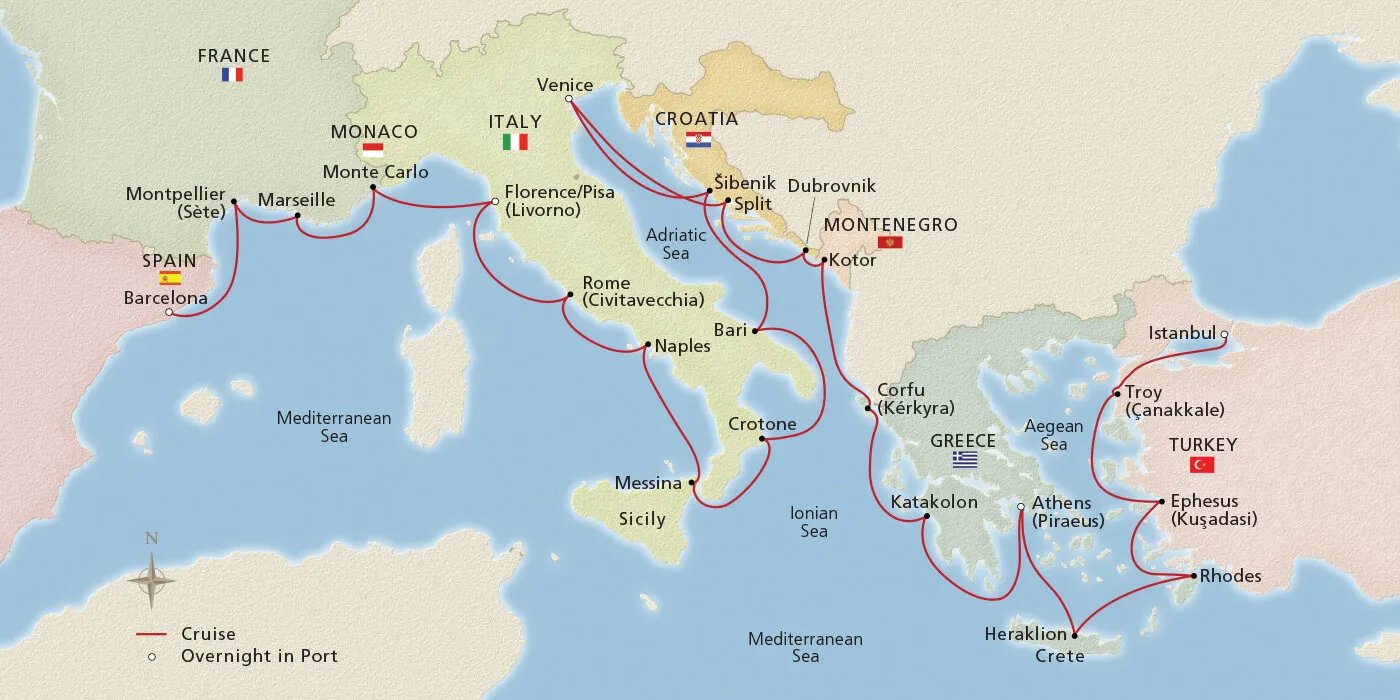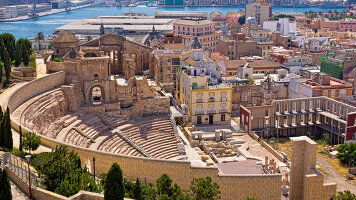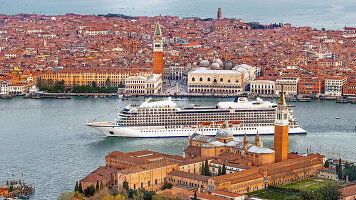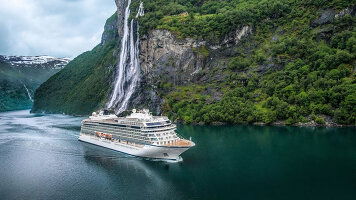Overview
Itinerary
Embark your ship and settle into your stateroom. The vibrant city of Barcelona, with its lively culture and inviting outdoor spaces, preserves a rich history. Picturesque medieval lanes wind through the oldest part of the city, the Gothic Quarter, where remnants of the city's Roman wall were uncovered. Its treasures include the neo-Gothic Barcelona Cathedral, the medieval Jewish district of El Call and the Romanesque Church of Santa Maria del Pi.
In the evenings, diners relax in the Royal Plaza at restaurants along the elegant square's perimeter.
Barcelona is steeped in history, with stunning architecture and a rich culture. Mediterranean breezes grace the shore and Catalonia's capital is a feast for the senses. Long strolls on wide boulevards—such as Las Ramblas, the mile-long leafy pedestrian way, and the Passeig de Gràcia, lined with some of Europe's most elegant buildings—set the tone for a city that moves to its own tempo. Native son and famed architect Antoni Gaudí adorned his city with whimsy, whether along fantastical city blocks or with his colossal masterpiece, the towering La Sagrada Família cathedral.
Montpellier has been a center of learning for centuries. Its namesake university, founded in 1160, is one of the world's oldest, predating the Renaissance. Still, a student population breathes life into a vibrant culture. The social and cultural center of Montpellier is the Place de la Comédie, anchored by the elegant Three Graces fountain and the neoclassical Opéra Comédie. Other sites pay tribute to a rich heritage, from the art-filled Musée Fabre and impressive St. Clément Aqueduct to the St. Pierre Cathedral with its 'floating' porch supported by a pair of towers.
Marseille is rich in historic treasures, nestled between the Mediterranean and rocky hills of limestone. Two 17th-century fortresses dominate the charming Vieux Port, or Old Port, the natural harbor that hosts all manner of watercraft, from sleek elegant yachts to old style fishing vessels. Its picturesque quay is one of the world's most romantic walks, lined with dozens of cafés and shops. Also worth exploring is the city center, graced by La Canebière boulevard. Linger in a café and sample the city's signature bouillabaisse made from freshly caught fish.
The chic city of Monte Carlo in the petite kingdom of Monaco boasts some of the world's most exclusive shopping and a beautiful old port. A fairy-tale aura has settled on this glittering city of the Grimaldi family, perhaps nowhere more elegantly than at the Prince's Palace, where the late American actress-turned-princess Grace Kelly presided with Prince Rainier III. Monte Carlo's medieval quarter perches on “The Rock,” an escarpment at the foot of the Maritime Alps, and offers spectacular views of the Mediterranean and the harbor lined with mega-yachts.
Tuscany is known equally as the cradle of the Renaissance and a center of culinary delights and astounding wines. Throughout this emerald-green countryside dotted with cypress trees, endless delights unfold. Among them is Florence, a living museum of the Renaissance. Brunelleschi's famous Duomo dominates the medieval cityscape—an architectural achievement. Another Tuscan treasure, the Square of Miracles, unfolds in Pisa. Here, a trinity of masterpieces—the Leaning Tower, Pisa Cathedral and Baptistery—comprise some of Europe's finest art and architecture.
Tuscany is known for its scenic beauty and exudes a unique, rustic character. Vineyards, olive tree groves, wheat fields and endless expanses of farmland skirt the bases of medieval hill towns as they march across an undulating landscape of gentle hills. Fertile soils produce some of the world's finest wines, including Chianti and Vino Nobile di Montepulciano. More than this, many consider Tuscany the birthplace of the original farm-to-table movement. Simple, honest food graces the Tuscan table, from creamy cheeses to thick Florentine steak grilled over a wood fire.
For centuries, Rome ruled much of Europe, building a vast empire from the power of emperors. More than 2,500 years of history live in the city's streets. Ancient structures recall those heady days when the cheers of 80,000 spectators roared from the Colosseum, citizens mingled in the Forum and senators asked the gods for guidance at the Pantheon. Along with the Vatican and St. Peter's Basilica, this rich pocket of Italy is one of the world's greatest repositories of history and civilization.
Naples boasts a long history in a stunning seaside setting and is known mostly for its pizza. The city has long been a major center of Italian culture and was the seat of a powerful independent kingdom for 500 years. So great was its sway that it lured the region's finest architects and artists. In the grand Piazza del Plebiscito, the grand and sweeping public square, the San Francesco di Paola Church flaunts a colonnaded facade reminiscent of the Pantheon in Rome, and the Royal Palace overlooks Neapolitans with statues of all the kings of Naples peering out from alcoves.
Sicily has been shaped by countless civilizations, from Greek to Byzantine to Roman. When it fell under Spain's purview in the 17th century, it was celebrated as one of Europe's ten great cities. Surrounded by undulating mountains, orange and olive groves and vineyards are plentiful. During World War II, Messina was the destination of the unofficial “Race to Messina” between US General Patton and British Field Marshall Montgomery. In the end, Patton arrived just hours before his British comrade, receiving credit for securing Sicily.
Crotone, according to Ovid, was named by Hercules himself in memory of a friend he had accidentally slain. Today, it is the capital of its eponymous province, a region known for its pristine waters, untouched mountains and vast forests. As the gateway to a landscape bestowed with great natural beauty, Crotone prides itself in its deep historical roots, which can be traced back to the 7th century BC in the city's archaeological museum and the ruins of two redoubtable fortifications, the Castle of St. Charles V and Le Castella, situated on a small peninsula south of the city.
Located at the heel of Italy's boot, Bari boasts a sunny, palm-lined promenade, romantic honey-toned balconied houses, welcoming courtyards, and Romanesque and baroque churches. It is pure pleasure to take in the distinct Mediterranean atmosphere of this picturesque port, with colorful fishing boats bobbing on the turquoise harbor. History and culture take center stage at the splendid Norman-Swabian Castle; the Romanesque Basilica of St. Nicholas, named for the city's patron saint; and the Petruzzelli Theater, one of Italy's most important opera houses.
Šibenik is the oldest Croatian city on the Dalmatian Coast. The remarkable architecture of this UNESCO World Heritage Site spans the centuries, having witnessed the rise and fall of empires, from Byzantine to Venetian. In its remarkably preserved Old Town, narrow cobblestone streets lead past medieval houses and churches, all surrounded by four historic fortresses, including the imposing St. Nicholas Fortress. St. James Cathedral, built by several architects in the Gothic and Renaissance styles over a century, is the most important Renaissance structure in Croatia.
Chioggia is a charming fishing community located at the southern end of the Venetian Lagoon and steeped in age-old seafaring traditions. Its combination of canals, bridges and fishing boats have lent it the nickname 'Little Venice.' Lined with shops, bars and restaurants, the main pedestrian street of Corso del Popolo exudes a lively atmosphere amid the aroma of delicious fresh seafood dishes. Chioggia shares a long history of cultural and economic ties with Venice, dating back to the Middle Ages, and is a scenic journey by water taxi from the capital of the Veneto region.
The Venetian Republic ruled Adriatic waves for a millennium. During the 8th century as the Roman Empire began to decline, many Europeans fled to Venice and its neighboring towns, including Chioggia. Merchants put their skills to use, and the city-state was soon thriving. The Venetian Lagoon's canal banks feature buildings influenced by Byzantine and Islamic architecture, reflecting Venice's powerful trading network. The first vaporetto traversed the Grand Canal in 1881; alongside the gondolas, these iconic Venetian water buses are at the heart of Venice's transport network.
Part of the Venetian landscape for centuries, the gondola was once the city's primary form of transport. During the 1500s, some 10,000 crafts plied the canals. The flat bottom was designed for the shallow depths of the Venice Lagoon, and its narrow width allowed the gondolier to achieve greater speed and maneuverability. Today, a few public gondolas serve as traghetti, or ferries, conveying people across the Grand Canal, while several hundred, painted black by local law, usher explorers into narrow canals, piloted by capped gondoliers in iconic striped shirts.
Built around the Roman Palace of Emperor Diocletian, Split is one of Croatia's oldest cities. Its promenade commands majestic views over a bay and the Adriatic Sea. Despite evidence of Split's origins in the 6th century BC, the city is traditionally considered over 1,700 years old—counting from the construction of the palace. Its well-preserved remains have been seamlessly assimilated into the modern city. An Ethnographic Museum is found at the palace's heart and shops line the passageways of its ancient basement. Diocletian's ancient mausoleum is now a stunning cathedral.
Dubrovnik is a historic jewel, with its spectacular Adriatic setting, 12th-century medieval streets and incredibly preserved structures. So stunning is its Old Town, the playwright George Bernard Shaw famously called it “paradise on Earth.” It is all spectacularly surrounded by a towering medieval wall. Inside, the ancient city's Stradun is lined with authentic stone houses. The peaceful 14th-century Franciscan Monastery and Apothecary, housing the world's oldest working pharmacy and fine collection of Renaissance paintings, provide insight into the ages.
Kotor is Montenegro's picturesque capital set amid glorious mountains and dramatic scenery. Towering cliffs soar above the narrow Kotor ria—a submerged river canyon often called Europe's southernmost fjord. Kotor is also home to one of the Adriatic's best-preserved medieval Old Towns. The charms of this red-roofed city are endless, from the mismatched towers of its Romanesque cathedral to its narrow streets. Its stunning Venetian walls were built in 1420, remnants from Kotor's nearly 300 years as a province of the Venetian Republic.
Corfu has a rich history shaped by conquerors and by royalty seeking tranquility. Corfu's Old Town and Fortress—fashioned by the once powerful Venetian Republic—comprise a UNESCO World Heritage Site. Its narrow warrens lead to one of Europe's largest public squares and a lovely promenade once exclusively reserved for the local aristocracy. Everywhere, magnificent coastal views unfold and scenic byways lead to history-rich enclaves, from the archaeological site of Paleopolis and the stunning Vlacherna Monastery to a former Greek royal villa.
Katakolon is huddled around a pretty little harbor dotted with colorful fishing boats. Nearby, the fertile valleys of the western Peloponnese are a bounty of olive groves, vineyards and orchards, and lead to the legendary city of Olympia. The well-kept ruins here transport visitors back to the days of the earliest athletes who competed for nothing less than the favor of the gods. The remains evoke the glory of the Games, and the Olympia Archaeological Museum features statues that once overlooked the site.
Athens has been called the “birthplace of democracy.” Its legacy looms large from atop Acropolis Hill, the pinnacle of ancient Greece. This open air museum is an astonishing repository of once-mighty structures. From its colonnaded Parthenon—more than 2,600 years ago—revered Greek philosophers like Plato and Aristotle formulated new ideas of government and debated its role in civic life to captivated audiences. Remnants of spiritual life are also here in the several temples to Athena and Zeus.
For a more intimate experience of Athens, the charming Plaka District invites guests with its labyrinth of cobblestone lanes. Neoclassical architecture lines the narrow streets of the “Neighborhood of the Gods,” so named for its location. Browsing its shops or simply perusing its nooks and crannies are pastimes favored by visitors and locals alike. This historic area is the ideal setting in which to enjoy traditional small plates of mezes and a sip of ouzo.
Crete was home to the Minoans, Europe's earliest recorded civilization. Its capital, Heraklion, grew from the riches of the Venetian Empire, which ruled here for four centuries. Crete enjoyed a Renaissance building boom that helped bolster Heraklion as the region's most strongly fortified city. The island is blessed with generous beaches, soaring mountains and coursing rivers. It is also where the distinct mantinades—couplets of love accompanied by Cretan instruments—could break out at any number of cafés where patrons sip tsikoudia, a grape-based brandy distilled in the hills.
Rhodes is home to the Palace of the Grand Masters, a remarkable and sprawling fortification. Its historic quarter is Europe's largest active medieval town. Outside the city, forests of pine and cypress blanket mountain slopes; vineyards and groves of citrus and olive soak up the Aegean sun. The Knights of Saint John of Jerusalem conquered the island in the 14th century, bringing great wealth from the Holy Land. Under their rule, the city was reconstructed to mirror the medieval ideal. Many of the buildings from this era remain and make for rewarding strolls.
One of antiquity's best-preserved cities, Ephesus offers an unparalleled look into the lives of the ancients. Many of its ruins have endured from the time Ephesus was one of the largest metropolises of the ancient world. Excavations reach back to the 10th century BC, when this city hosted one of the Seven Wonders of the Ancient World—the Temple of Artemis. Today, Ephesus is still full of wonders: the towering facade of the Library of Celsus, the massive amphitheater that once sat 25,000 spectators and residences adorned with frescoes.
Çanakkale was an object of desire dating back to the ancient Greeks. Today, the nearby ruins of Troy, once a powerhouse of Asia Minor, provide a glimpse of the region's former glory. The remarkably preserved structures of this UNESCO World Heritage Site offer hints of life here in the days of Alexander the Great and the later Roman Emperor Augustus. But it is the fabled Trojan Horse that is most prominent here. In Homer's Iliad, the wooden steed gave ancient Greeks entry to the city during the Trojan War, and its legend is still very much alive today.
Istanbul exudes a fascinating mix of Western and Eastern cultures. Its strategic locale led to its role as a significant center of trade—eventually becoming a cultural crossroads along the world-famous Silk Road. One of the city's stunning centerpieces is Hagia Sophia, founded as a basilica, converted to a mosque, then a museum; it is now a mosque again and features exquisite mosaics and frescoes. The city's Grand Bazaar offers a rich taste of Turkish culture, from a vast selection of carpets and fabric to luscious dates and the local sweet favorite, Turkish Delight.
Straddling Europe and Asia across the Bosphorus Strait, no other city in the world bridges two continents. Istanbul's history is evident on every corner, from the cascading domes of the Blue Mosque to the courtyards of the Topkapi Palace. Visitors and locals alike flock to the European districts of Karaköy and Galata to browse shops and visit galleries, while across the strait lie the fashionable areas of Kadıköy and Moda.
At night, the Old Town's buildings illuminate the skies, and across the Sea of Marmara, twinkling lights of ships follow a trail to the Asian continent. After breakfast, disembark your ship and journey home.
Life Onboard Viking Jupiter
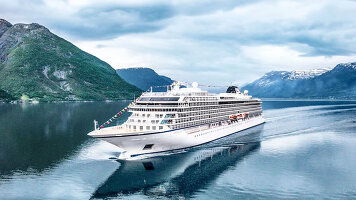
Launched in 2019, the Viking Jupiter is Vikings' newest all-veranda ship, part of a fleet of award winning, state of the art ships incorporating all the comforts & luxuries you would expect from Viking. Read more
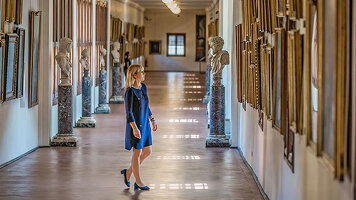
Viking are destination experts. With no casinos or children on board, you can be assured that the focus is firmly on enrichment and education. Read more

After a day of exploration or just to enhance the relaxation of a day at sea, the on-board Spa will leave you feeling recharged and revitalized. Read more

Viking offer eight on board dining options. Beer, wine and soft drinks are available with lunch and dinner at no additional charge of fee. Read more
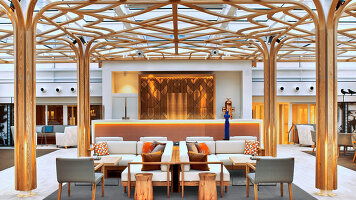
Viking proudly includes all that you need and nothing you do not. A variety of features and services valued at $200 per person per day are standard inclusions in your cruise. Read more

Viking include one complimentary shore excursion in every port of call. Enjoy exclusive entry to cultural treasures and seldom-seen collections around the world. Read more

Trip Reviews (2) Most Recent 'Mediterranean's Iconic Shores' Reviews
Download Brochure
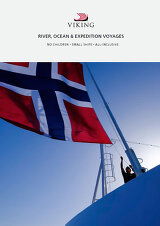
Viking River, Ocean & Expedition Voyages (2025-27)
Dates & Pricing
 USD
USD
Viking Cruise $25 Deposits!
Cabin Layout Options:
Select Cabin Preference:
Tour & cruises prices are per person. Prices shown have savings applied, are subject to availability and may be withdrawn at any time without notice. Pricing and trip details are correct at this point in time, however are subject to confirmation at the time of booking and are subject to change by Viking. For cruise itineraries, cabin images are sourced from the cruise-line and should be treated as indicative only. Cabin inclusions, upholsteries and room layout may differ to the image(s) shown depending on the ship selected and your sailing dates.



